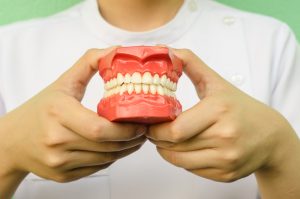 Discussions about your smile’s appearance are common. After all, as one of the first things that people notice about you (apart from your eyes), your smile is one of the most dominant features of your face and can speak volumes about your personality, confidence, friendliness.
Discussions about your smile’s appearance are common. After all, as one of the first things that people notice about you (apart from your eyes), your smile is one of the most dominant features of your face and can speak volumes about your personality, confidence, friendliness.
However, confidence in your smile depends as much on how well it functions as how good it looks, and ensuring your mouth’s proper function is the first step to a full mouth reconstruction. With extensive experience in restoring patients’ smiles through full mouth reconstruction, we explain the tenets of restoring your mouth’s function.
Start with a Strong Foundation
Like any good structure, your mouth is at its strongest when it sits upon a healthy foundation. Where your oral health is concerned, this foundation consists of soft gingival tissue (gums) and jawbone. The roots of your teeth are embedded in your jawbone, and when your gums are healthy, they form an airtight seal for additional support and protection. Whether you need to reinvent your smile through a full-mouth reconstruction, or merely undergoing a routine dental checkup, ensuring your gums are free of disease is paramount to the rest of your oral health.
As the number one cause of adult tooth loss in America, gum disease can negatively affect your ability to retain natural teeth, and if not purged beforehand, it can undermine your dental restorations. Left unchecked, the disease can extend beyond your gum tissue and affect the supporting jawbone that surrounds your teeth, as well. Together, gum disease and tooth loss can lead to jawbone deterioration and facial collapse (the sunken-jaw appearance that is evident years after untreated tooth loss).
All in the Movement
Though your teeth and gums may be as healthy as ever, your mouth’s importance lies mainly in its ability to move. Chewing, biting, speaking, swallowing, and other mouth functions involve the movement of your jaw, which is dictated by a pair of joints, called TMJs (temporomandibular joints), located in front of each ear. These joints connect your lower jaw to your skull and help displace the pressure of your bite, but can only operate properly when correctly aligned.
Due to excessive pressure, trauma, malocclusion (crooked teeth), or a number of other factors, your jaw can moved out of alignment, causing your jaw’s muscles to work harder. The strain can lead to excruciating discomfort known as TMJ disorder, and the imbalance can lead to excessive wear and damage to your teeth and gums. Therefore, ensuring that your teeth and jaws are properly aligned is as important as guaranteeing the health of your jawbone and gums for your mouth to continue functioning well.




Recent Comments